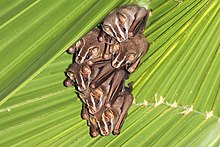| Tent-making bat | |
|---|---|

| |
| Scientific classification | |
| Domain: | Eukaryota |
| Kingdom: | Animalia |
| Phylum: | Chordata |
| Class: | Mammalia |
| Order: | Chiroptera |
| Family: | Phyllostomidae |
| Genus: | Uroderma |
| Species: | U. bilobatum
|
| Binomial name | |
| Uroderma bilobatum Peters, 1866
| |

| |
The tent-making bat (Uroderma bilobatum) is an American leaf-nosed bat (Phyllostomidae) found in lowland forests of Central and South America.[2] This medium-sized bat has a gray coat with a pale white stripe running down the middle of the back. Its face is characterized by a fleshy nose-leaf and four white stripes. Primarily a frugivore, it may supplement its diet with insects, flower parts, pollen, and nectar. Its common name comes from its curious behavior of constructing tents out of large, fan-shaped leaves. These roosts provide excellent protection from the tropical rains, and a single tent roost may house several bats at once. This bat is quite common in its geographic range; hence, its conservation status is listed as Least Concern.
- ^ Solari, S. (2019). "Uroderma bilobatum". IUCN Red List of Threatened Species. 2019: e.T22782A22048748. doi:10.2305/IUCN.UK.2019-2.RLTS.T22782A22048748.en. Retrieved 14 March 2022.
- ^ Simmons, N.B. (2005). "Order Chiroptera". In Wilson, D.E.; Reeder, D.M (eds.). Mammal Species of the World: A Taxonomic and Geographic Reference (3rd ed.). Johns Hopkins University Press. p. 425. ISBN 978-0-8018-8221-0. OCLC 62265494.
